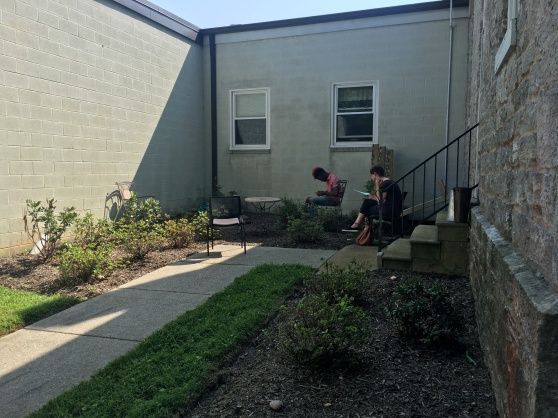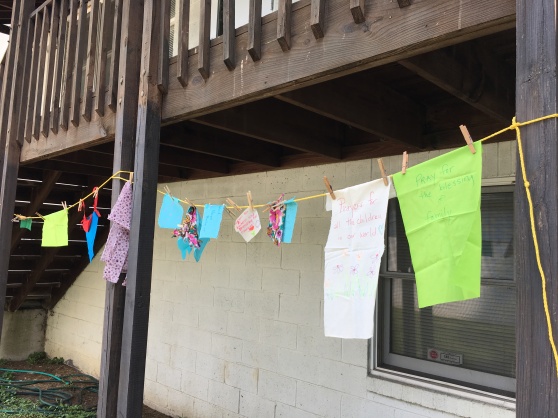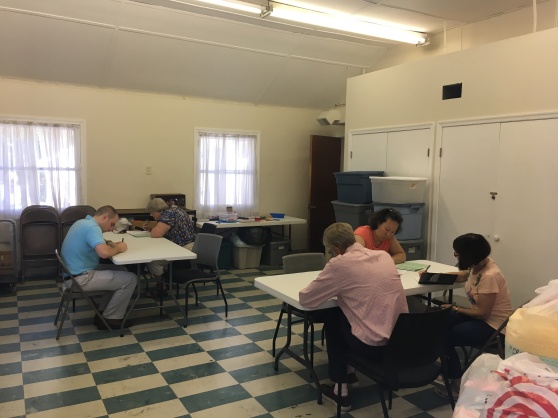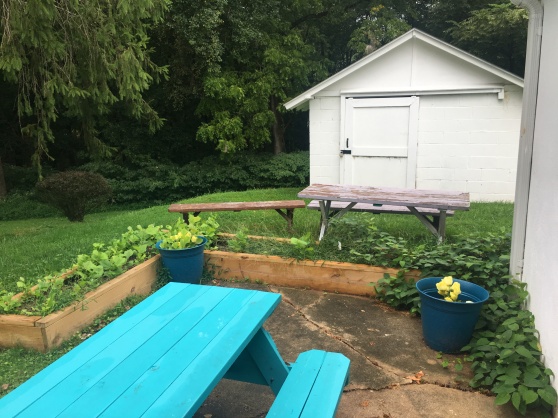We had our annual outdoor worship and picnic August 26, 2018 at Ashland Presbyterian Church. Here’s what we did.

Prayer Station #1: Breath Prayer
In the beginning when God created the heavens and the earth, the earth was a formless void and darkness covered the face of the deep, while a breath from God swept over the face of the waters. –Genesis 1:1-2
A breath prayer is a type of prayer that allows us to connect with God no matter where we are or what we’re doing. In a breath prayer, we pray to the rhythm of our own breathing, which we intentionally slow down. The breath prayer can be a prayer in itself, or it can lead into further prayer. By practicing breath prayers regularly, you allow a “spirit break” that becomes as natural as breathing.
Here’s how you do it: Close your eyes. Breathe in slowly; then breathe out slowly. Repeat this several times. Say the first line of the breath prayer (while breathing in). For example: Lord. Then, breathe out slowly, give the second line of the breath prayer, have mercy. Repeat the prayer several times (it could be a four or five or several minutes worth, allowing other thoughts to disappear and concentrating on your breathing, essentially, you are not “saying” the word but “breathing” it) and then allow time for silence. Close this time of breath prayer with a simple prayer maybe “thank you Jesus for your love, Amen.” You may use one of the following breath prayers or create one of your own using a line of music, a poem, another Bible verse, and so on.
Spirit of the Living God, fall afresh on me.
Be still, and know God.
Create in me, a clean heart.
This is the day, the Lord has made.
Fear not, I am with thee.
Peace, be still. God, is here.

Prayer Station #2: Prayer Flags
Then Jesus led the disciples out as far as Bethany, and, lifting up his hands, he blessed them. While he was blessing them, he withdrew from them and was carried up into heaven. And they worshiped him, and returned to Jerusalem with great joy; and they were continually in the temple blessing God. -Luke 24:50-53
Prayer flags are colorful pieces of fabric with prayers inscribed on them. They are often found in the Himalayas to bless the environment around them. The belief is that as these prayers are blown by the wind, as they become frayed and tattered, the prayers bless the world. The wind carries the blessing into small villages and into bustling cities, into war-torn nations and to peaceful people. The wind carries a prayer of strength to that widow mourning the death of her husband. The breeze blows blessing into that home and over that newborn baby boy resting in the arms of his mother.
1. Pray and meditate. Search the caverns of your heart and mind for the prayers. Perhaps it is a prayer for peace or a prayer of thanks. Recall your day, your week. Did you witness or hear something that caused you to invoke God? Perhaps it was the man asking for money on the street corner. Pray with your kids. Ask them to come up with their own prayers and blessings.

2. Craft the flags. As you cut the cloth or paper into squares, pray your prayer. Remember that each prayer you craft is an offering to God. Be artsy. Be plain. Write out your prayers. Draw something. Attach a photo. Let your children make their own; let them go crazy with their creativity.
3. Hang the twine somewhere that you will see it everyday. Maybe in your kitchen so you can gaze at the prayers each morning as you prepare for the day. Maybe in your backyard between two trees. Maybe even over your child’s bed. Make them visible.
4. Attach each prayer to the twine and let the Holy Spirit take over. Keep these prayers always on your mind. Visit the prayer flags daily. Pray the flags often.

Prayer Station #3 Gratitude Journal
“Then one of them, when he saw that he was healed, turned back, praising God with a loud voice.” – Luke 17:15
As people of faith we know that living a life of gratitude is beneficial to our heath. But in our busy lives sometimes we forget to reflect of the abundance of blessings we have received. Using the materials provided create a gratitude journal. Place it on your nightstand or kitchen table so you remember to write in it each day. Here are some prompts to help you get started
• Use the prompt, “I’m grateful for…” and fill it in as completely as possible. Try to come up with five things each day.
• This is a twist on the first practice; instead of writing a full sentence on what you’re grateful for, just boil it down to one word. So it could be, “children” “brownie” “Earth” etc. Feel the essence of each word as you write it.
• Draw your gratitude each day, or do something creative. The instructions are simple – instead of writing your gratitudes in sentence form, draw them out. Or, paint them. Sing them. Dance them. Make a collage. Whatever suits your fancy.
• Write your daily gratitude, and share it with someone else. Once you’ve written it in your journal, write a note to the person you are thankful for, or a letter to someone letting them know the wonderful things happening in your life.
• If your life is so stressful you cannot think of anything to be grateful for, simply write something for the future. Write whatever your heart desires, and act like you already have it.

Station #4 Preparing the Soil
When a great crowd gathered and people from town after town came to him, he said in a parable: “A sower went out to sow his seed; and as he sowed, some fell on the path and was trampled on, and the birds of the air ate it up. Some fell on the rock; and as it grew up, it withered for lack of moisture. Some fell among thorns, and the thorns grew with it and choked it. Some fell into good soil, and when it grew, it produced a hundredfold.” As he said this, he called out, “Let anyone with ears to hear listen!” –Luke 8:4-8
Last spring raised beds were planted outside the fellowship hall kitchen to grow vegetables and herbs to be cooked for our dinners at Sarah’s Hope. The preschool children will be planting and learning about how food grows in the beds, but like any good gardener knows, the soil must be prepared. Pull the weeds away from the beds and prepare the pots for the new plants to grow.
As you pull the weeds consider the things in your life that need to be pulled away so you can flourish with what God has called you to be. Discuss these things with your neighbors or write them in your journal at a later date. Return to the garden in a month or two and notice the progress the “good soil” has provided for our ministries.




